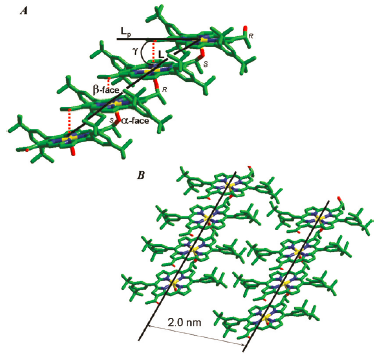Title: Anisotropic Organization and Microscopic Manipulation of Self-Assembling Synthetic Porphyrin Microrods That Mimic Chlorosomes: Bacterial Light-Harvesting Systems Journal of the American Chemical Society
Authors: Chappaz-Gillot, C., Marek, P. L., Blaive, B. J., Canard, G., Bürck, J., Garab, G., Hahn, H., Jávorfi, T., Kelemen, L., Krupke, R., Mössinger, D., Ormos, P., Reddy, C. M., Roussel, C., Steinbach, G., Szabó, M., Ulrich, A. S., Vanthuyne, N., Vijayaraghavan, A., Zupcanova, A., Balaban, T. S.
Take Home Importance According to Blogger: Authors demonstrate an interesting way of taking mechanical advantage of the long-range directional properties of self-assembled rods.

Summary: Chlorosomes are the primary light-harvesting organelles of certain photosynthetic bacteria. Within these chlorosomes are bacteriochlorophylls (BChls) which efficiently harvest light and transport the absorbed energy to reaction centers. The high energy transfer efficiency of chlorosomal BChls consequently makes these constructs of intense interest for artificial solar harvesting. The authors describe their characterization and manipulation of synthetic BChl rods in this paper.
Core to these synthetic self-ordered BChls are porphyrins metalated with either zinc or magnesium. In concentrated solutions the molecules aggregate in rods. The presence of the central metal ion (Zn or Mg) is described as crucial for this particular type of aggregation to occur, with the carbonyl- or hydroxyl-containing side arms of each individual porphyrin serving to ligate to the central metal ion of a separate metal ion. In this way the rods ‘click’ together via electrostatic interactions. Figure 1 illustrates these interactions.
With the self-assembled rods in hand, the authors manipulated individual rods using magnetic fields, electric fields, and even tribomechanical fields which result from the interactions of surfaces in motion; in this case, the relative motion of the rods relative to the solvent in which the rods were suspended in. Fascinatingly, individual rods could also be rotated with optical tweezers as demonstrated in the video at the end of this post. Why can these rods be manipulated at all? The proposed reason lies in the anisotropy of the properties of the individual porphyrin molecules from which the rods were constructed. An example – when incoming radiation interacts with a single porphyrin ring there is a strong preference for the radiation to drive a separation of charge across the plane of the porphyrin ring. In other words, the primary transition dipoles are orientated parallel to the plane of the porphyrin. As the tendency of the porphyrin building blocks to absorb light is greater in certain orientations among other properties, so will the overall rod demonstrate a directional properties, or anisotropy of the properties. One consequence may be that placing a rod in an electric field causes the rods to orient a certain direction – which was indeed observed by the authors. Overall, the authors clearly highlight how molecular anisotropy can be used to induce directional properties in larger molecular aggregates, suggesting practical applications in the manufacture of devices.
[youtube http://www.youtube.com/watch?v=hkWdxzp46x0&w=300&h=315]
video supplied in the paper’s supporting information

